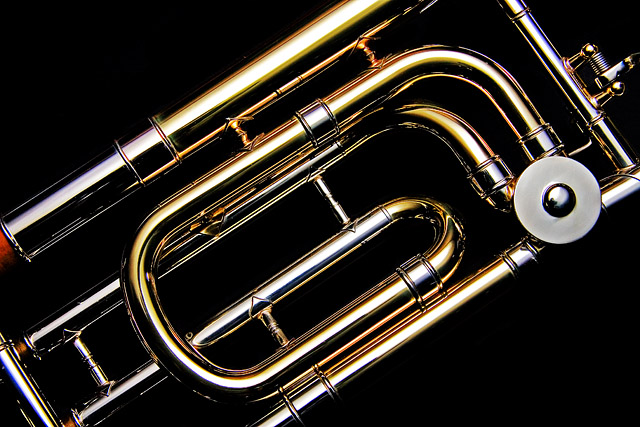Tenorposaune : May 17, 2008

Image Data
File Name: 20D_23790
Model: Canon EOS 20D
Lens: Canon EF-S 17-85mm F4-F5.6 IS USM
Date: 05.16.08 11:53pm
Focal Length: 38mm (61mm)
Shutter: 1/250 s
F-Stop: F8
ISO: 200
Program: Manual
Metering Mode: Evaluative
Flash: On
Flash Details: Manual
Focus Mode: Manual focus
File Name: 20D_23790
Model: Canon EOS 20D
Lens: Canon EF-S 17-85mm F4-F5.6 IS USM
Date: 05.16.08 11:53pm
Focal Length: 38mm (61mm)
Shutter: 1/250 s
F-Stop: F8
ISO: 200
Program: Manual
Metering Mode: Evaluative
Flash: On
Flash Details: Manual
Focus Mode: Manual focus
A tenor trombone contains a whole 9 feet of tubing. Add on a standard F-attachment (pictured here), and you're up to 12 feet of brassy goodness. The first carnation of the contrabass trombone during the Renaissance had a whopping 24' of tubing!
The word trombone derives from Italian tromba (trumpet) and -one (a suffix meaning "large"), so the name literally means "large trumpet". Trombones and trumpets share the important characteristic of having predominantly cylindrical bores. Therefore, the most frequently encountered trombones - the tenor and bass trombone - are the tenor and bass counterparts of the trumpet. They are both pitched in B? — with the slide all the way in, the notes of the harmonic series based on B? can be played - but trombones generally read music in concert pitch.
The word trombone derives from Italian tromba (trumpet) and -one (a suffix meaning "large"), so the name literally means "large trumpet". Trombones and trumpets share the important characteristic of having predominantly cylindrical bores. Therefore, the most frequently encountered trombones - the tenor and bass trombone - are the tenor and bass counterparts of the trumpet. They are both pitched in B? — with the slide all the way in, the notes of the harmonic series based on B? can be played - but trombones generally read music in concert pitch.















 Subscribe
Subscribe


